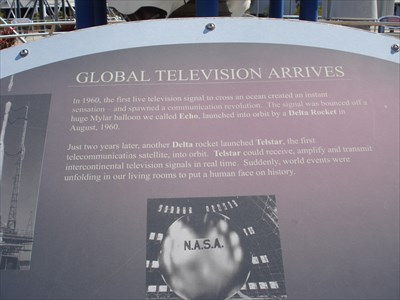
Global Television Arrives
In 1960, the first live television signal to cross an ocean created an instant sensation - and spawned a communication revolution. This signal was bounced off a huge Mylar balloon we called Echo, launched into orbit by a Delta Rocket in August 1960.
Just two years later, another Delta rocket launched Telstar, the first telecommunications satelitte, into orbit. Telstar could receive, amplify and transmit intercontinental television signals in real time. Suddenly, world events were unfolding in our living rooms to put a human face on history.
From: Wikipedia
Telstar
Telstar is the name of various communications satellites, including the first ever such satellite able to relay television signals.
The first two Telstar satellites were "Telstar 1", launched July 10, 1962 and operational until February 21, 1963, and "Telstar 2", launched May 7, 1963 and operational until May 16, 1965. They were experimental, and nearly identical. Telstar 1 relayed the first television pictures, telephone calls and fax images through space and provided the first live transatlantic television feed.
Description
Belonging to AT&T, the original Telstar was part of a multi-national agreement between AT&T, Bell Telephone Laboratories, NASA, the British General Post Office, and the French National PTT (Post, Telegraph & Telecom Office) to develop experimental satellite communications over the Atlantic Ocean. Bell Labs held a contract with NASA, reimbursing the agency three million dollars for each of the two launches, independent of success. The US ground station was Andover Earth Station in Andover, Maine, built by Bell Labs. William H Gill Jr. was a technician working for AT&T at that time and assisted in the technical details of the communications.[citation needed] The main British ground station was at Goonhilly Downs in southwestern England, and it was used by the BBC. It was the international coordinator and the standards 525/405 conversion equipment (filling a large room) was researched and developed by the BBC and located in the BBC Television Centre, London. The French ground station was at Pleumeur-Bodou (48°47'10?N 3°31'26?W? / ?48.78611°N 3.52389°W? / 48.78611; -3.52389) in north-western France.
The satellite was built by a team at Bell Telephone Laboratories, including John Robinson Pierce who created the project, Rudy Kompfner who invented the traveling wave tube transponder used in the satellite, and James M. Early who designed the transistors and solar panels for it. The satellite is roughly spherical, measures 34.5 inches (876.30 mm) in length, and weighs about 170 pounds (77 kg). Its dimensions were limited by what would fit in one of NASA's Delta rockets. Telstar was spin-stabilized, and its outer surface was covered with solar cells to generate electrical power. The power produced was a tiny 14 watts.
The original Telstar had one innovative transponder to relay data, which was a television channel or multiplexed telephone circuits. An omnidirectional array of small antenna elements around the satellite's "equator" received 6 GHz microwave signals to be relayed. The transponder converted the frequency to 4 GHz, amplified the signals in a traveling-wave tube, and retransmitted them omnidirectionally via the adjacent array of larger box-shaped cavities. The prominent helical antenna was for telecommands from a ground station.
Launched by NASA aboard a Delta rocket from Cape Canaveral on July 10, 1962, Telstar 1 was the first privately sponsored space launch. A medium-altitude satellite, Telstar was placed in an elliptical orbit completed once every 2 hours and 37 minutes, inclined at an angle of approximately 45 degrees to the equator, with perigee about 1000 km from Earth and apogee about 6000 km from Earth (This is in contrast to most of today's communications satellites, which are placed in circular geostationary orbits.)
Due to its non-geosynchronous orbit, Telstar's availability for transatlantic signals was limited to 20 minutes in each orbit that passed over the Atlantic Ocean. Ground antennas had to track the satellite as it came around the world approximately every two and a half hours. Since the transmitting and receiving radio systems on board Telstar were not nearly as powerful or capable as those of today's satellites, the ground antennas had to be huge. Morimi Iwama and Jan Norton of Bell Laboratories were in charge of designing and building the electrical portions of the system that steered the antennas. The aperture of the antennas was 3,600 square feet (330 m2). The antennas were 177 feet (54 m) long and weighed 380 tons. The antennas were housed in radomes the size of a 14-story office building. The challenge was to steer the huge antennas to track the satellite that moved up to 1.5 degrees per second with a pointing error of less than 0.06 degrees.